When you buy through our links, we may earn an affiliate commission.
Let’s be honest. Noise gate pedals are the last thing that comes to mind when discussing guitar pedals. This is understandable since they don’t produce flashy, dramatic effects like other pedals.
However, noise gate pedals serve an important purpose. They are mostly used by professional guitar and bass players—either onstage or in a recording studio—when they want to block undesired signals that pop up in electric setups.
When used correctly, noise gate pedals can help bring your sound to another level and even enhance the effects of other pedals in your chain.
Our top pick is the Electro-Harmonix Silencer because of its incredible versatility, its built-in effects loop, and flexible controls.
Let’s look at some more of the best noise gate pedals!
Quick Summary of the Best Noise Gate Pedals
- Electro-Harmonix Silencer (Our Top Pick)
- MXR M135 Smart Gate Pedal (Our Runner-up)
- Boss NS-2 Noise Suppressor (Most Versatile)
- ISP Technologies Decimator II (Premium Choice)
- Donner Noise Killer (Budget Choice)
- TC Electronic Iron Curtain (Best Under $50)
- TC Electronics Sentry (Best Under $150)
- Pigtronix Gatekeeper Micro (Best Mini Pedal)
Best Noise Gate Pedals
1. Our Top Pick – Electro-Harmonix Silencer
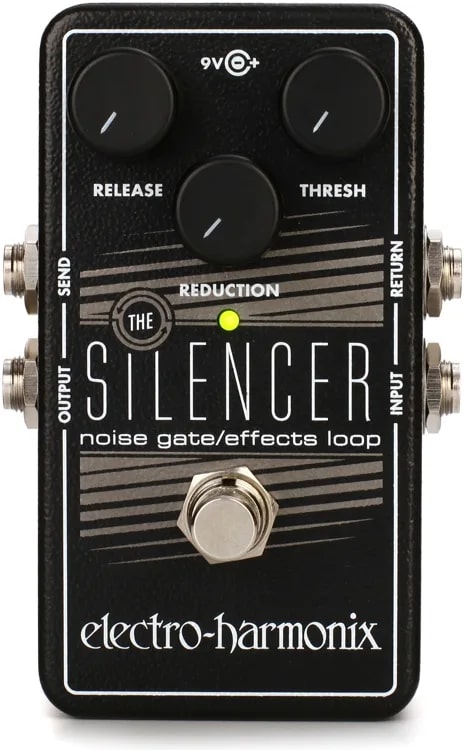
SPECS
- Controls: Threshold, Release, Reduction
- Bypass: Buffered bypass
- Type: Analog
A sophisticated noise gate that can tame a single pedal or an entire effects loop, the EHX Silencer’s three-control layout provides precise fine-tuning to fit your system, axe, and playing style.
The Silencer’s Threshold knob adjusts how much level is required to open the noise gate and allow a signal to pass through.
The Reduction knob regulates the degree to which the gated signal is reduced and is variable between -70dB and +4dB.
Finally, the Release knob controls how long the gate remains open after the signal drops below the Threshold. Release time is variable between 8ms and 4 seconds.
The Silencer also features Send and Return Jacks and uses buffered bypass, which allows the effects loop to remain in your signal path when the gate is bypassed.
This is, without a doubt, one of the best noise gate pedals on the market.
2. Our Runner-Up – MXR M135 Smart Gate Pedal
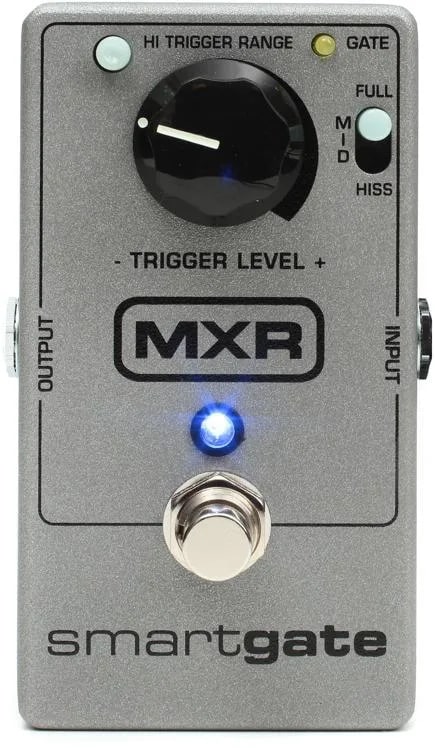
SPECS
- Controls: Trigger level, Trigger range, Mode
- Bypass: N/A
- Type: Analog
MXR manufacturer is known for its wide selection of high-quality pedals, and the MXR M135 is their top-tier noise gate pedal.
Perhaps the most exciting feature of the M135 is the MXR Smart Gate technology. This pedal tracks your signal and reacts slowly when it recognizes that you’re playing a chord so that the sustain is in no way affected. It is also capable of recognizing more aggressive playing and snapping shut at the right time.
The Smart Gate is also equipped with three selectable types of noise reduction to handle virtually any type of signal. The three modes are Hiss for high-frequency noise, Mid for noisy guitar amps, and Full for wide-range signals and bass rigs.
The MXR Smart Gate also features a hardwire bypass, a precise threshold trigger, and amazingly clean circuitry. It’s incredibly durable and portable for reliable noise reduction on the go.
The M135 is particularly suited for guitarists who play high-gain music such as metal and heavy rock.
3. Most Versatile – Boss NS-2 Noise Suppressor
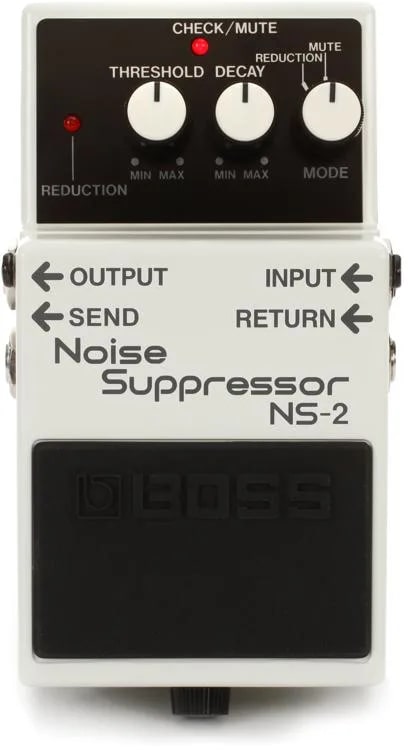
SPECS
- Controls: Threshold, Decay, Mode
- Bypass: Buffered bypass
- Type: Analog
The Boss NS-2 noise suppression pedal has been around for a while, which only goes to show that it is still one of the best noise gates pedals around.
Like all Boss pedals, the NS-2 has a robust look and feel with a compact design. It offers incredibly reliable performance, eliminating unwanted noise and hum without altering an instrument's natural tone.
The Boss NS-2 has a unique and fast noise detection circuit that preserves the natural attack and envelope of your instrument's sound, effectively separating the guitar input signal and the noise components.
This noise reduction pedal features a send/return loop that isolates drives and an amp preamp, a Threshold knob, a Decay knob, and a Mode knob that allow you to shape the elimination/suppression as desired, and Mute and Reduction knobs.
The Mute mode makes the pedal active only when the footswitch is pressed, while the Reduction mode keeps the pedal always on.
The NS-2 is compatible with guitar and bass and is a very versatile noise gate pedal, great for many different styles and types of players.
4. Premium Choice – ISP Technologies Decimator II
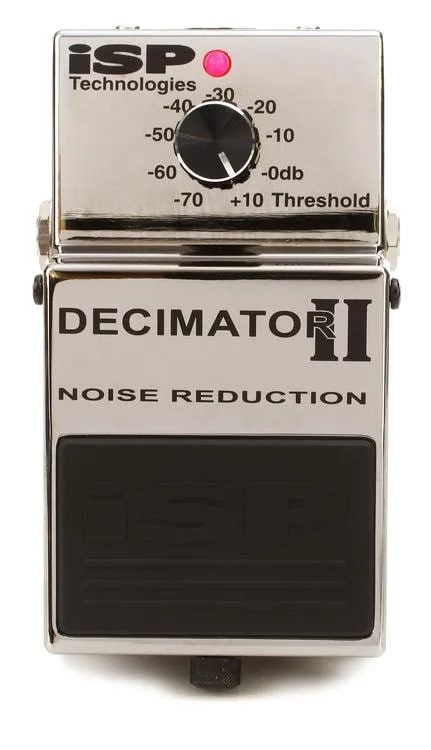
SPECS
- Controls: Threshold
- Bypass: Buffered bypass
- Type: Digital
The Decimator II is ISP Technologies’ second generation of the Decimator Noise Reduction. With improved performance and unique innovations, it has become one of the best phaser pedals on the market. It is also one of the most expensive options on this list.
The Decimator II features their groundbreaking Linearized Time Vector Processing, which increases the smoothness and transparency of the release response and virtually eliminates any release ripple for incredibly smooth decay of longer sustained notes.
The Decimator II also includes a LINK IN and LINK OUT that link two pedals via a common 1/8 inch cable, linking both pedals to accurately track your input signal.
Its large, stompbox pedal design makes this pedal very easy to use with its single threshold knob, and it’s built like a tank, so it can withstand heavy use.
This particular model doesn’t come with a send/return to isolate problem pedals, but the Decimator II G String, its slightly more expensive cousin, does.
5. Budget Choice – Donner Noise Killer
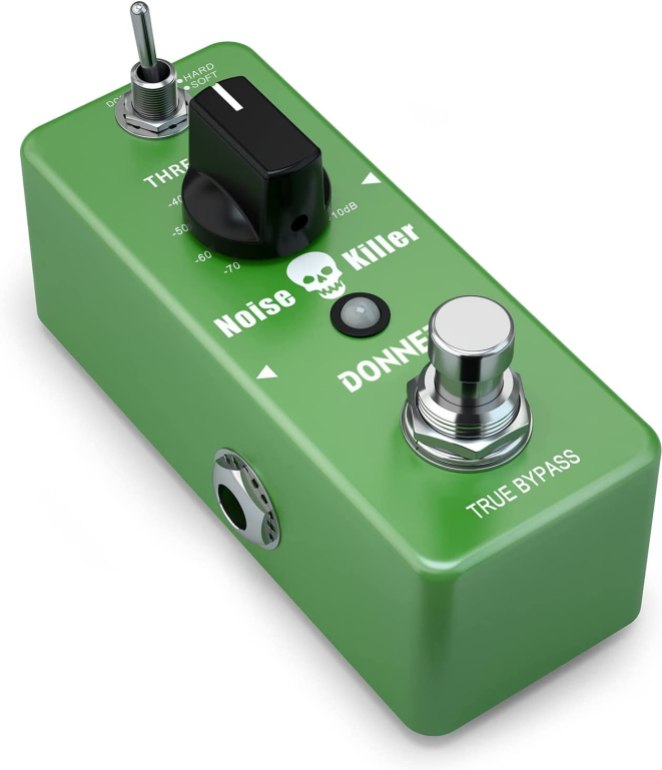
SPECS
- Controls: Threshold
- Bypass: True bypass
- Type: Digital
The Donner Noise Killer pedal is not only incredibly affordable but also really simple to operate.
This compact pedal might be small, but its aluminum alloy construction feels solid and robust and will fit perfectly in any pedalboard, no matter how crowded.
The Noise Killer detects any unwanted signal and offers quick and smooth noise reduction. This is great for both live and home recording situations.
This noise reduction pedal offers two noise reduction modes to choose from: hard and soft modes. This refers to the gating intensity. Hard mode is for an aggressive response, and Soft mode is if you want a smoother response.
The Noise Killer also has a basic threshold knob so you can adjust the level at which the signal is cut. The threshold range is from -70db to 10db.
The Noise Killer is durable, reliable, and super easy to use—in all, it’s the best noise gate pedal for people on a tight budget.
6. Best Under $50 – TC Electronic Iron Curtain

SPECS
- Controls: Threshold, Decay
- Bypass: True bypass
- Type: Digital
The TC Electronic Iron Curtain is another great option for people on a tight budget whose guitar signal has gotten a bit overcrowded due to noisy electrical wiring or Radio Frequency Interference.
The Iron Curtain is a bulky and durable pedal, so it might not be a great fit if you have a crowded pedalboard. Otherwise, this little tank can be a great option if you want a straightforward noise-reduction pedal.
Its no-nonsense design means it is incredibly easy and intuitive to operate. It only has two knobs: Threshold and Decay.
This 2-knob layout makes it easy to dial in a superbly responsive guitar sound, whether you’re grinding massive-gain metal or playing blues on single coil pickups.
Additionally, it features a true bypass design that maintains your tone when the effect isn't in use.
The Iron Curtain is perfect for high-gain players who don’t need all the bells and whistles of other more complex pedals but who also need a high-resistance pedal that can take a lot of abuse.
7. Best Under $150 – TC Electronics Sentry

SPECS
- Controls: Threshold, Decay, Mode, Damp
- Bypass: Switchable (True bypass & Buffered bypass)
- Type: Digital
We couldn’t resist adding this second entry by TC Electronics: the groundbreaking Sentry. It might be on the more expensive end of the spectrum, but it is the best noise gate pedal for people who want all those fantastic extra features.
Featuring TC's cutting-edge multiband System 6000 technology, the Sentry Noise Gate is one of the most advanced noise gate pedals on our list, offering seamless, organic-sounding noise reduction.
The Sentry also prevents choppy cut-offs that ruin your music, offering a seamless, natural-sounding decay instead.
The Sentry is also loaded with a classic hard-gate mode for instant noise removal, as well as a Send/Return loop for patching noisy pedals through or creatively sidechaining in other audio signals.
Last but certainly not least, the Sentry comes with TC’s renowned Tone Print Editor software that allows you to connect the pedal to a computer and gain access to dozens of downloadable presets or create your own customized gates.
This truly is a premium noise gate pedal that is worth every penny.
8. Best Mini Pedal – Pigtronix Gatekeeper Micro
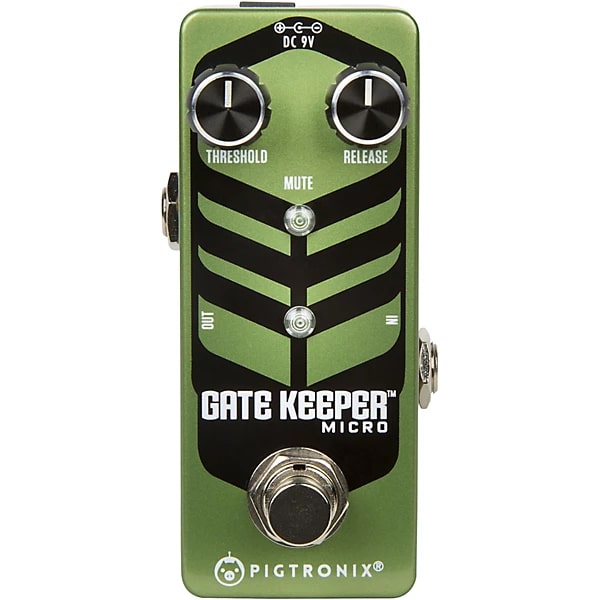
SPECS
- Controls: Threshold, Release
- Bypass: True bypass
- Type: Analog
The Pigtronix Gatekeeper Micro is a pro-grade noise gate pedal that will fit perfectly into any pedalboard.
Featuring Threshold and Release knobs, Gatekeeper provides attenuation with unprecedented response time and utilizes ultra-high-speed J-FET circuitry to completely eliminate hum, hiss, buzz, and any other intrusive non-musical sounds from your signal path.
Its wide range Threshold control combines with exceptional headroom to deliver smooth transient response previously available only in studio-oriented noise gate processors.
The addition of the Release knob lets you control how long it takes the gate to slam closed.
Given how small and simple it is, the price tag might be a bit much for some people. But if you’re in the market for a premium-quality pedal but don’t have much space on your pedalboard, then the Gatekeeper Micro is worth looking into.
Best Noise Gate Pedals Buyer's Guide
What Is a Noise Gate Pedal?
Noise gate pedals reduce the amount of unwanted noise—namely hissing and humming—that is primarily caused by noisy pickups and using high gain.
When the signal falls below a pre-set “threshold,” the gate “closes” and cuts out the signal, preventing humming in between playing. The gate “opens” when you start playing again, and the level is above the pre-set threshold.
A good noise gate pedal won’t color the tone of your guitar and has no undesired effects, such as shortening sustained notes. For further noise suppression when recording read our soundproof curtains & blankets reviews.
Features to Consider While Choosing a Noise Gate Pedal
Interface
Every noise gate pedal is going to look a little different, and they all have different features that may or may not work for you, depending on what you want out of your pedal.
However, the two most important features that your noise gate pedal should have are threshold and decay controls.
Threshold
The threshold control lets you set the level at which the pedal will cut off the signal. Setting the threshold low will cut out almost all unwanted noise while setting a high threshold will remove only the most abrasive signals.
You’ll need to play around a little with this setting to find the balance of eliminating noise like humming or hissing without cutting your notes too short.
You’ll also need to readjust the threshold if you change any part of your rig. This means it’s important to make a note of where the sweet spot is with each setup so you can quickly adjust it in the future.
Decay
The decay knob—also known as the release or time control—determines how quickly the noise gate pedal is activated when you preset the threshold.
If your decay is slow, then the noise gate will close slowly, giving your sound a more natural and softer quality.
A fast decay means the noise gate will close right when your signal reaches the threshold and can sound choppy and even robotic.
Again, it’s important to find the right balance where the decay isn’t so fast that your sound becomes choppy but also isn’t so slow that the gate doesn’t cut the signal at the right time, making the pedal useless.
Some basic pedals don’t have decay knobs but instead, have a decay mode switch that allows you to switch between high and low decay settings without any adjustability in the middle.
Additional Features
As we mentioned before, some pedals have additional features that you might want to look into.
Pedals like the Boss NS-2 come with Mute and Reduction modes. Reduction mode is used to eliminate unwanted noise that is determined by the Threshold level, while the Mute mode mutes all sound once the pedal is activated, acting like a kill switch to provide dead silence.
Another example is the TC Electronics Sentry, which comes with a Damp knob that is used for signal attenuation.
There are many other features that you may or may not want or need in your noise gate pedal, so make sure to get one that fits your needs.
Size
We know all too well that pedalboard space is at a premium, especially when you already have an extensive setup.
Most manufacturers are aware of this too, though, and will usually try to make noise gate pedals as compact and unobtrusive as possible so that they can be easily accommodated.
Consider your current setup before deciding on your first noise gate pedal. You might find that you have enough space to go for a slightly bigger and more complex pedal.
If you’re the type of musician who needs to move their setup around a lot, you should also consider the weight of your noise gate pedal. Opting for a smaller and, therefore, lighter pedal will make transportation a lot easier.
Frequently Asked Questions (FAQs)
What is the difference between a noise suppression pedal and a noise gate?
A noise gate pedal will completely shut off the sound when it hits the pre-set threshold, while a noise suppressor pedal cuts only certain frequencies. A noise gate will close when the signal is below the threshold, while a noise suppressor pedal never closes.
What causes unwanted noise?
Your Amp
Valve amps tend to get louder as they age. Solid-state amps are more reliable and therefore don’t produce as much noise. If you are using an analog and high-gain amp in particular, then there will inevitably be some buzz.
Volume and Gain
All amps produce a certain level of static, which is unavoidable. However, the more you boost gain or volume, the more hum you’ll get.
EQ Settings
Boosting treble or mid frequencies will also accentuate any unwanted noise your amp is producing.
Types of Pickups
Single-coil pickups tend to generate more noise. Humbuckers, on the other hand, are designed to reduce hum.
AC Supply
The quality of your mains supply can also affect the amount of noise your rig makes. If the quality of power in your area is poor, this can cause your rig to produce a much less ‘clean’ sound.
Radio and static interference
Phones, radios, Bluetooth devices, and electrical appliances can all cause unwanted noise if they happen to be close enough to your guitar or amp.
Where do you place a noise gate pedal in the signal chain?
Noise gate pedals can be placed anywhere in the pedal chain, but always before time-based effects pedals like reverb and delay, or they’ll interfere with their performance.
They can also be used to target specific problems. For instance, if your fuzz pedal is creating a lot of background humming, then you can place the noise gate pedal after it. Likewise, if your pickups are the problem, then you can place them toward the start of the chain.
Many artists like to put a noise gate after high-gain pedals, which allows the pedal to handle the noise produced when a lot of gain is pushed into your signal.
Another common placement for a noise gate pedal is after an overdrive, distortion, or fuzz pedal since they generally create the most background noise.
Do you actually need a noise gate pedal?
Now that you know what a noise gate does, it’s time to decide if you should actually add one to your pedalboard lineup.
Noise gate pedals are useful if you are noticing high levels of hissing and humming while you’re playing. Many musicians regard this hum as part of the electric guitar sound and prefer not to remove it.
Other musicians find this hum annoying and detrimental to their guitar tone. If you’re a part of the latter camp, then a noise gate pedal might be right for you.
Additionally, this type of unwanted noise is common when using high gain, which is why a lot of heavy rock and metal players need noise gate pedals.
Another reason to buy a noise gate pedal is if your guitar has single coil pickups, which are particularly noisy.
Conclusion
Sick and tired of that annoying hum ruining your music? Now you have the perfect solution! And with this guide, you also know which are the best noise gate pedals and, more importantly, which is the right one for you.
Our top pick is the Electro-Harmonix Silencer because of its incredible versatility, its built-in effects loop, and flexible controls.
If you’re looking for a straightforward pedal with no bells and whistles, then the MXR M135 Smart Gate Pedal is another excellent choice.
Give noise gate pedals a try and get rid of unwanted noise once and for all!
